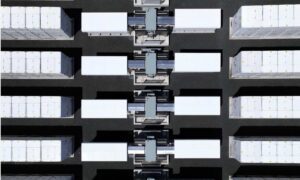Researchers from Philadelphia’s Drexel University say they have developed a commercially viable method of creating lithium-sulphur batteries that avoids previous dangerous pitfalls, and would result in batteries with three times the capacity of lithium-ion batteries and able to last more than 4,000 cycles.
Despite its proliferation through consumer electronics and electric vehicles, traditional lithium-ion batteries are not particularly ground-breaking, especially when compared to other potential battery chemistries.
Moreover, some of the materials needed for lithium-ion batteries are scarce and/or expensive, and retrieving more of them can be detrimental to the environment.
This has sparked a search for new chemistries such as lithium-sulphur batteries, which offer greater performance and storage, and rely on more abundant materials.
However, introducing sulphur into a lithium battery along with the commercially friendly and preferred carbonate electrolyte has been difficult, due to what the researchers describe as “an irreversible chemical reaction between intermediate sulfur products, called polysulfides and the carbonate electrolyte”.
In previous attempts to use a sulphur cathode in a battery with a carbonate electrolyte solution, this has resulted “in nearly immediate shut down and a complete failure of the battery after just one cycle.”
However, new research from Drexel University’s College of Engineering – published in the journal Communications Chemistry – offers a commercially viable method of sidestepping these issues.
“Sulphur has been highly desirable for use in batteries for a number of years because it is earth-abundant and can be collected in a way that is safe and environmentally friendly, and as we have now demonstrated,” said Vibha Kalra, PhD, George B. Francis Chair professor in Drexel College’s department of chemical and biological engineering, who led the research.
“it also has the potential to improve the performance of batteries in electric vehicles and mobile devices in a commercially viable way.”
The researchers attempted to confine sulphur in the carbon nanofiber cathode substrate using a “vapor deposition technique.” While this process did not succeed in embedding the sulphur within the nanofiber mesh, it did something extraordinary, which revealed itself when the team began to test the cathode.
“As we began the test, it started running beautifully – something we did not expect. In fact, we tested it over and over again – more than 100 times — to ensure we were really seeing what we thought we were seeing,” Kalra said.
“The sulphur cathode, which we suspected would cause the reaction to grind to a halt, actually performed amazingly well and it did so again and again without causing shuttling.”

The unlooked-for solution was the fact that, during the process of depositing the sulphur on the carbon nanofiber surface during which it transforms from a gas to a solid, the sulphur crystallised in an unexpected way to form a slight variation of the element, called monoclinic gamma-phase sulphur.
This chemical phase of sulphur had previously only been created at high temperatures in labs and, therefore, had only been observed in nature in the extreme environment of oil wells.
“At first, it was hard to believe that this is what we were detecting, because in all previous research monoclinic sulfur has been unstable under 95 degrees Celsius,” said Rahul Pai, a doctoral student in the Department of Chemical and Biological Engineering and coauthor of the research.
“In the last century there have only been a handful of studies that produced monoclinic gamma sulphur and it has only been stable for 20-30 minutes at most.
“But we had created it in a cathode that was undergoing thousands of charge-discharge cycles without diminished performance — and a year later, our examination of it shows that the chemical phase has remained the same.”
The Drexel researchers continued testing for more than a year and found that the sulphur cathode remained stable, with no degradation over 4,000 charge-discharge cycles – equivalent to around 10 years of regular use.
Similarly, and as predicted, the sulphur cathode battery boasts a capacity more than three-fold that of a lithium-ion battery.
“While we are still working to understand the exact mechanism behind the creation of this stable monoclinic sulphur at room temperature, this remains an exciting discovery and one that could open a number of doors for developing more sustainable and affordable battery technology,” Kalra said.
The unexpected breakthrough could revolutionise battery development.
“Having a cathode that works with the carbonate electrolyte that they’re already using is the path of least resistance for commercial manufacturers,” the researchers note.
There have been efforts in the past to make sulphur work as a battery material, such as experimental research that used an ether electrolyte rather than a carbonate.
But while lithium-sulphur batteries have demonstrated exceptional performance in these conditions, they are not commercially viable, considering that the ether electrolyte is highly volatile and has components with a boiling point as low as 42 degrees Celsius – a problematic issue to say the least.
“Having a cathode that works with the carbonate electrolyte that they’re already using is the path of least resistance for commercial manufacturers,” Kalra said. “So rather than pushing for the industry adoption of a new electrolyte, our goal was to make a cathode that could work in the pre-existing Li-ion electrolyte system.”
Maybe most importantly, however, is the fact that a lithium-sulphur battery such as that demonstrated in Drexel’s recent research will alleviate the need for sourcing the large quantities of cobalt, nickel, and manganese which are currently required in existing chemistries.
“Getting away from a dependence on lithium and other materials that are expensive and difficult to extract from the earth is a vital step for the development of batteries and expanding our ability to use renewable energy sources,” Kalra said.
“Developing a viable Li-S battery opens a number of pathways to replacing these materials.”







